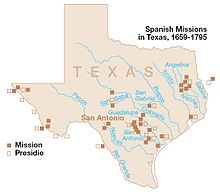Join Date: Apr 2008
Location: Austin, TX
Posts: 4,891
Las misiones de San Antonio - Herencia española en Texas - SkyscraperCity
Las misiones de San Antonio - Herencia española en Texas
Las misiones españolas en el estado de Texas datan desde el siglo XVIII. Las que están ubicadas a lo largo del Rio San Antonio en ese entonces se habían convertido en la mayor concentración de misiones españolas en todo Norte América. Estas misiones fueron establecidas para expandir la influencia española hacia el norte de México, tambien fueron usadas para introducir las poblaciones nativas a la cultura española.
Cuatro de estas misiones (San José, San Juan, Concepción y Espada) fueron originalmente establecidas en el éste de Texas pero debído a continua sequías, malaria y la incursión francesa fueron relocadas a lo largo del Rio San Antonio.
Estas misiones florecieron a mediados del siglo XVIII pero debído al inadecuado apoyo militar, enfermedades y continua hostilidad con tribus Apache y Comanche, éstas declinaron.
Misión de El Alamo (1718). La primera y mejor conocida de estas misiones. San Antonio de Valéro, comunmente llamada El Alamo, fué establecida en 1718 como una estación puente entre otras misiones en el éste de Texas y las misiones de México. Cuando la batalla de el Alamo se llevó a cabo, la cual ocurrió en Marzo 6 de 1836, esta misión ya tenía 100 años de existencia pero siempre va a ser recordada por su asociación con ésa batalla.
Monumento a los héroes de El Alamo

Misión San José (1720). Luego después de la fundación de El Alamo la segunda misión fué fundada en 1720 unas millas aboajo en las riberas del Rio San Antonio. Esta misión fue fundada por Fray Antonio Margil de Jesús quien antes había abandonado otra misión fallída en el éste de Texas. Un modelo entre las misiones de Texas, San José adquirió reputación por ser un importante centro cultural y social, entre todas las misiones es la que proveía una mejor defensa al poseer el fuerte mejor construído y que la protegía en contra de los ataques indígenas.
Entrada principal con su portal de estílo Churriguresco

Edificaciones a lo largo de las paredes del fuerte.

Parte exterior del fuerte.

Misión San Juan (1731). Originalmente establecida en el éste de Texas, Misión San Juan Capistrano hizo su hogar permanente a las orillas del Rio San Antonio en 1731. En poco tiempo se convirtió en un centro importante de abastecimiento de productos agrícolas así como de otra índole, como hierro, madera, telas, y artículos de cuero los cuales eran producidos por los indígenas residentes en la misión. Unas millas al sud-éste estaba el rancho Pataguilla el cual en 1762 reportaba 3,500 cabezas de cabras e igual número de ganado.
Entrada principal del fuerte.

Vista de la capilla la que corre a un lado y no detrás de la fasada principal.



 3Víctor
3Víctor LinkBack URL
LinkBack URL About LinkBacks
About LinkBacks












 Citar
Citar




















Marcadores